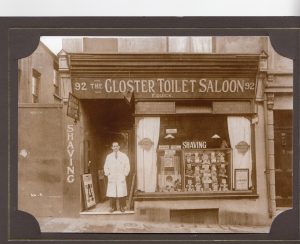I have been unable to find any evidence that there was a formal training scheme to help disabled ex-servicemen become hairdressers. The most usual route into the profession was to be trained by a skilled man. I have a picture of Patrick standing outside his place of work. The Gloster Toilet Saloon was situated at 92 Gloucester Road, Brighton. (The spelling of the road name seems to have varied over time.) The premises, still recognisable, are now occupied by a clothing shop. The proprietor was E Quick.
 Some basic family history research reveals that the E stands for Ernest. He was born in April 1880 in Exeter, the son of Robert and Bertha (from the 1881 census) or Sarah (from 1891). By 1901 he has moved to Hackney where he is a boarder. He is already a hairdresser by this time. In March 1911 he is in Edmonton, North London, living with his widowed father. He married Maud in October 1911 in Kilburn. The first child, May, was born in 1913, in Tottenham. Edna followed in 1914 by which time the family had moved to Brighton. The third child was born in September 1916. He was named Ronald Stanley Quick. There was then a significant gap until Donald appeared in 1922. There is a good reason for the interval.
Some basic family history research reveals that the E stands for Ernest. He was born in April 1880 in Exeter, the son of Robert and Bertha (from the 1881 census) or Sarah (from 1891). By 1901 he has moved to Hackney where he is a boarder. He is already a hairdresser by this time. In March 1911 he is in Edmonton, North London, living with his widowed father. He married Maud in October 1911 in Kilburn. The first child, May, was born in 1913, in Tottenham. Edna followed in 1914 by which time the family had moved to Brighton. The third child was born in September 1916. He was named Ronald Stanley Quick. There was then a significant gap until Donald appeared in 1922. There is a good reason for the interval.
In 1915, the family is living at 92 Gloucester Road, Brighton. They are obviously living above the barber’s shop. Ernest ‘attested’ for military service in December of that year. His occupation is shown as ‘Master Hairdresser’. In so doing, he was agreeing to be called up should the need arise. He was at the back of the queue to be taken into the Army because he was a married man with young children. He was also 35 years of age. He was immediately placed on the Army Reserve. He was finally called up for service in January 1917. He seems to have spent brief periods in the Bedfordshire Regiment, the Suffolk Regiment and the Northamptonshire Regiment. He spent the rest of the war in the Labour Corps, which was created in February 1917. He was demobilised in April 1919. Thus far there is no significant connection to Patrick. They had both served in the Army, but in different branches. It is unlikely that they met whilst serving. They both called Brighton their home by the middle of the War, but so did thousands of other servicemen and women.
There are two documents relating to a claim for a disability pension in the service records for Ernest Quick. The rank for the pension claim is Class 5. This means that he was a Private, the lowest scale. The disability code was 35. This refers to “Functional diseases of the central nervous system (to include neurasthenia and shell shock)”. There are three subdivisions: ‘Attributable’ (caused by military service), ‘Aggravated’ (pre-existing condition made worse by military service) and ‘non-attributable’. A gun shot wound suffered at the front is clearly ‘attributable’. Pre-existing asthma could easily be ‘aggravated’ by exposure to a gas attack. Being injured by a runaway wagon would probably be classified as ‘non-attributable’ on the grounds that the individual should have jumped out of the way. The Ministry of Pensions developed a reputation for parsimony.
On 7/6/1922, Ernest Quick had his claim for a 20% disability pension rejected. “No grounds for award” was written on the form. His neurasthenia was seen as both non-attributable and non-aggravated. He must have been seen as having a nervous disposition. The decision must have been referred to an Entitlement Appeal Tribunal. The date on the second document is not legible but is probably late 1923. This time, the neurasthenia was classified as ‘aggravated’. A 20% award (8 shillings per week) was dated from 31/5/1923 to 7/11/1923 and a subsequent award to run from 8/11/1923 to 11/11/1924. I am assuming that the first part was a backdated payment. The award is still classed as ‘conditional’. As such, it was subject to reviews. There is no evidence that it continued beyond the end of 1924.
I think that this provides the link to Patrick. He had suffered gun shot wounds (leaving him with much reduced strength in his right arm) and had been gassed. He spent time coughing every morning when he woke up. He was in receipt of a disability pension of 11 shillings a week. His award was reviewed at least once. The procedure required him to travel to London for assessment. It seems likely that Patrick and Ernest met either at the Tribunal or whilst travelling to or from Brighton. Both would have been worried about the possible loss of benefits. Both would have been unhappy with the way that they were being treated. It seems likely that Ernest offered to train Patrick. I do not know when the training started. My father, born September 1923, was christened Ronald. Is this a clue?
